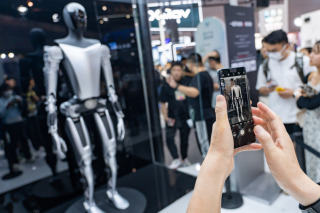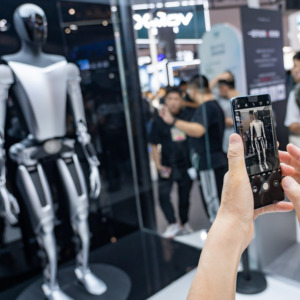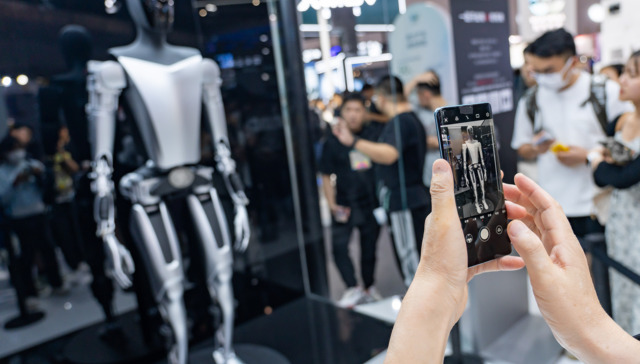By LI Biao
Elon Musk is pleased with his Optimus robots. During the World Artificial Intelligence Conference (WAIC) in Shanghai, through a video link, the founder and CEO of Tesla and SpaceX told the world – and not for the first time - that he expects androids to eventually outnumber humans.
Not taking over any time soon
Tesla's robot Optimus made its debut in China at this year's WAIC, attracting large crowds. At 173cm and 73kg – a BMI most of us can only dream of – Musk expects platoons of Optimus to be marching off the production line in as little as three years. Musk plans to sell his smart dolls for around US$20,000 each and expects to sell a million of them each year.
In Musk's vision, billions of humanoid robots will embody the ultimate form of Artificial General Intelligence (AGI). These robots – a word derived from the Russian for "worker" – will possess the ability to think and reason and have flexible limbs and a physical body that looks like your own, but in better shape. The robots will have sharp, agile senses – they will see and hear much better than you do and will be equipped for deep interactions with their human masters, if such a term seems appropriate.

With superior computational power to mere biological machines, robots are poised to assist humans in all kinds of undesirable tasks, which some may see as a waste of the robots' prodigious talents, perhaps even the robots themselves. Presumably, the robots will be programmed not to complain, despite how their sharp, agile senses may make them feel.
Desirable, legal and controllable?
Since the emergence of ChatGPT, robot companies have made no secret of their pursuit of more intelligent and more human-like robots along the path of embodied intelligence. Dataa Robotics released its robot at WAIC. Deep Robotics brought along a frisky, acrobatic robot "dog."
Robots, in all kinds of guises, were strutting their stuff throughout the venue. Everyone seems to have one or plans to. FOMO is rife in the industry. The future is a robotic one.
However, while excitement over large language models runs riot in the industry and beyond, there is no shortage of also more cautious voices. Branded naysayers or luddites, many people from all walks of life are concerned about unregulated robot development.
What application scenarios are desirable, legal and controllable? How far are we from achieving embodied intelligence in a machine? And what will happen when we get there?
Rubik's Cubes and other pressing problems
For decades now there have been stories, rumors and big-budget movies celebrating robots liberating humans from odious toil. But still, we work.
The robotics industry has long faced a classic paradox, the "easy" problems in the human world are the most difficult to solve for the robots. Simple actions like sitting down and standing up require highly complex mechanical control systems. But does a robot really need to sit?
Everyday tasks such as cooking, making coffee, or moving objects involve breaking down the processes into atomistic micro-events while maintaining the overall "shape" of the task. The cumulative difficulty of these seemingly "easy" problems increases exponentially.
Progress in precision motion lags far behind the advancements in large language models. Making the robot talk turns out to be a lot easier than making it walk. OpenAI previously made a robotic arm capable of solving a Rubik's Cube with one hand. However, due to insufficient data and implementation challenges, the project was discontinued in 2021.
Stuck in the hardware stage
The CEO of a large AI model company at the WAIC told Jiemian News that, unlike the logical reasoning of "dialogue robots" based on software platforms or higher-level "generative emergence," commercially active robots and industrial robots primarily follow an automation control route required for solutions to mechanical control problems.
Algorithms can only go so far in solving these matters. Most of the research and engineering bottlenecks are stuck at the hardware stage, such as sensors and controllers. The integration of intelligent software and hardware is still in its early stages.
White-collar solution to blue-collar issue
Turing Award winner Andrew Yao told WAIC that the speed of reinforcement is still insufficient to meet the requirements for embodied capabilities that involve thinking and action. The most practical scenario for large AI models right now is assisting humans with paperwork.
According to a report by Goldman Sachs, it is estimated that 300 million jobs worldwide will be replaced by generative AI, with the legal and administrative sectors being the most affected. Physical labor-intensive occupations or outdoor professions – those who do the work commonly seen as "undesirable," - will be less uplifted and liberated. Dangerous and boring construction and maintenance work will continue much as it does today.
In 2015, China had a robot density of only 49 units per 10,000 people. By 2021, the number had reached 322, surpassing the United States. According to national strategic goals, this number is expected to reach 482 by 2025.





